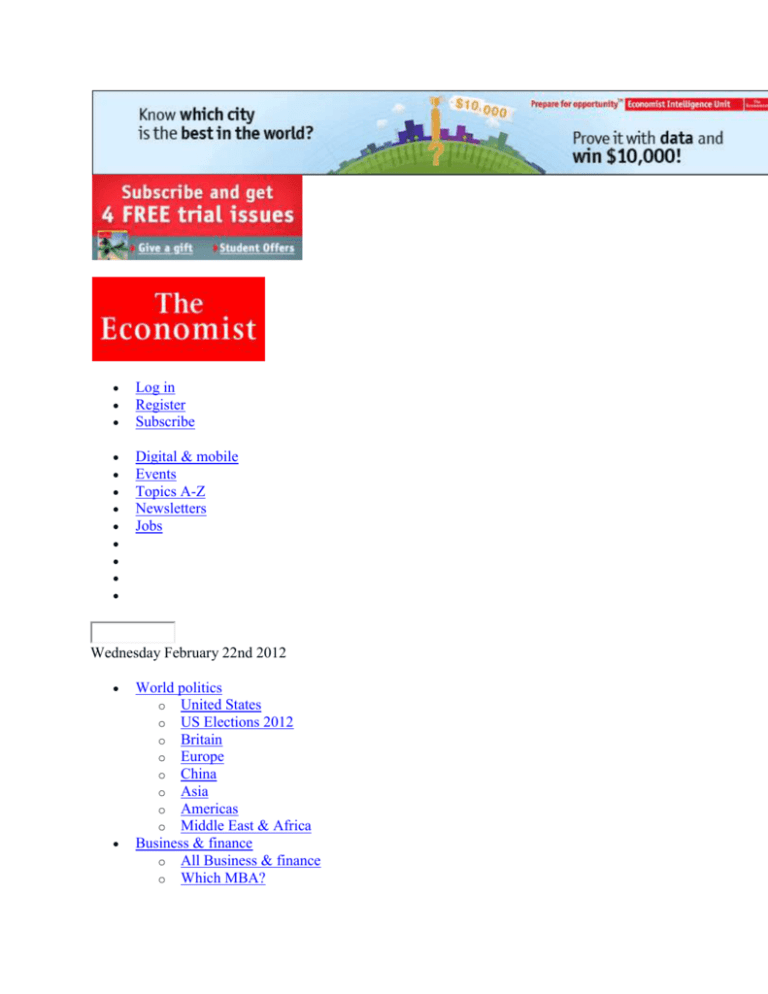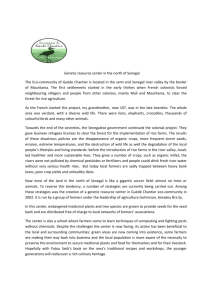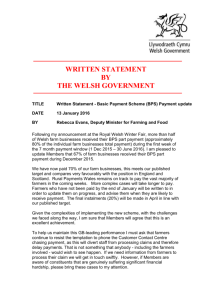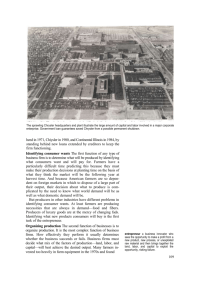
Log in
Register
Subscribe
Digital & mobile
Events
Topics A-Z
Newsletters
Jobs
Wednesday February 22nd 2012
World politics
o United States
o US Elections 2012
o Britain
o Europe
o China
o Asia
o Americas
o Middle East & Africa
Business & finance
o All Business & finance
o Which MBA?
o
Business Books Quarterly
Economics
o All Economics
o Economics by invitation
o Markets & data
o Economics A-Z
Science & technology
o All Science & technology
o Technology Quarterly
Culture
o All Culture
o More Intelligent Life
o Style guide
o The Economist Quiz
The World in 2012
Blogs
o Latest blog posts
o Eastern approaches
o Americas view
o Free exchange
o Babbage
o Game theory
o Bagehot's notebook
o Graphic detail
o Banyan
o Gulliver
o Baobab
o Johnson
o Blighty
o Leviathan
o Buttonwood's notebook
o Lexington's notebook
o Cassandra
o Multimedia
o Charlemagne's notebook
o Newsbook
o Clausewitz
o Prospero
o Democracy in America
o Schumpeter
Debate
o Economist debates
o Economics by invitation
o Ideas arena: Women & work
o Letters to the editor
o What the world thinks
Multimedia
o World
o Business & economics
o Science & technology
o Culture
o Events
o The Economist in audio
Print edition
Current issue
Previous issues
Special reports
Politics this week
Business this week
Leaders
KAL's cartoon
Food and the poor
The new face of hunger
Global food shortages have taken everyone
by surprise. What is to be done?
Apr 17th 2008 | from the print edition
SAMAKE BAKARY sells rice from wooden basins at Abobote market in the northern suburbs
of Abidjan in Côte d'Ivoire. He points to a bowl of broken Thai rice which, at 400 CFA francs
(roughly $1) per kilogram, is the most popular variety. On a good day he used to sell 150 kilos.
Now he is lucky to sell half that. “People ask the price and go away without buying anything,” he
complains. In early April they went away and rioted: two days of violence persuaded the
government to postpone planned elections.
“World agriculture has entered a new, unsustainable and politically risky period,” says Joachim
von Braun, the head of the International Food Policy Research Institute (IFPRI) in Washington,
DC. To prove it, food riots have erupted in countries all along the equator. In Haiti, protesters
chanting “We're hungry” forced the prime minister to resign; 24 people were killed in riots in
Cameroon; Egypt's president ordered the army to start baking bread; the Philippines made
hoarding rice punishable by life imprisonment. “It's an explosive situation and threatens political
stability,” worries Jean-Louis Billon, president of Côte d'Ivoire's chamber of commerce.
Last year wheat prices rose 77% and rice 16% (see chart 1). These were some of the sharpest
rises in food prices ever. But this year the speed of change has accelerated. Since January, rice
prices have soared 141%; the price of one variety of wheat shot up 25% in a day. Some 40km
outside Abidjan, Mariam Kone, who grows sweet potatoes, okra and maize but feeds her family
on imported rice, laments: “Rice is very expensive, but we don't know why.”
In this section
»The new face of hunger
Reviving the ration card
Reprints
Related items
How countries cope: Reviving the ration cardApr 17th 2008
Food: The silent tsunamiApr 17th 2008
Bangladesh: A different sort of emergencyApr 17th 2008
China's grain supply: The ravening hoardsApr 17th 2008
Famine, farm prices and aid: Food for thoughtMar 27th 2008
Related topics
Social issues
Food security
Africa
Cote d'Ivoire
Abidjan
The prices mainly reflect changes in demand—not problems of supply, such as harvest failure.
The changes include the gentle upward pressure from people in China and India eating more
grain and meat as they grow rich and the sudden, voracious appetites of western biofuels
programmes, which convert cereals into fuel. This year the share of the maize (corn) crop going
into ethanol in America has risen and the European Union is implementing its own biofuels
targets. To make matters worse, more febrile behaviour seems to be influencing markets: export
quotas by large grain producers, rumours of panic-buying by grain importers, money from hedge
funds looking for new markets.
Such shifts have not been matched by comparable changes on the farm. This is partly because
they cannot be: farmers always take a while to respond. It is also because governments have
softened the impact of price rises on domestic markets, muffling the signals that would otherwise
have encouraged farmers to grow more food. Of 58 countries whose reactions are tracked by the
World Bank, 48 have imposed price controls, consumer subsidies, export restrictions or lower
tariffs.
But the food scare of 2008, severe as it is, is only a symptom of a broader problem. The surge in
food prices has ended 30 years in which food was cheap, farming was subsidised in rich
countries and international food markets were wildly distorted. Eventually, no doubt, farmers
will respond to higher prices by growing more and a new equilibrium will be established. If all
goes well, food will be affordable again without the subsidies, dumping and distortions of the
earlier period. But at the moment, agriculture has been caught in limbo. The era of cheap food is
over. The transition to a new equilibrium is proving costlier, more prolonged and much more
painful than anyone had expected.
“We are the canary in the mine,” says Josette Sheeran, the head of the UN's World Food
Programme, the largest distributor of food aid. Usually, a food crisis is clear and localised. The
harvest fails, often because of war or strife, and the burden in the affected region falls heavily on
the poorest. This crisis is different. It is occurring in many countries simultaneously, the first
time that has happened since the early 1970s. And it is affecting people not usually hit by
famines. “For the middle classes,” says Ms Sheeran, “it means cutting out medical care. For
those on $2 a day, it means cutting out meat and taking the children out of school. For those on
$1 a day, it means cutting out meat and vegetables and eating only cereals. And for those on 50
cents a day, it means total disaster.” The poorest are selling their animals, tools, the tin roof over
their heads—making recovery, when it comes, much harder.
Because the problem is not yet reflected in national statistics, its scale is hard to judge. The effect
on the poor will depend on whether they are net buyers of food or net sellers (see article); for
some net buyers, the price rises may be enough to turn them into sellers. But by almost any
measure, the human suffering is likely to be vast. In El Salvador the poor are eating only half as
much food as they were a year ago. Afghans are now spending half their income on food, up
from a tenth in 2006.
On a conservative estimate, food-price rises may reduce the spending power of the urban poor
and country people who buy their own food by 20% (in some regions, prices are rising by far
more). Just over 1 billion people live on $1 a day, the benchmark of absolute poverty; 1.5 billion
live on $1 to $2 a day. Bob Zoellick, the president of the World Bank, reckons that food inflation
could push at least 100m people into poverty, wiping out all the gains the poorest billion have
made during almost a decade of economic growth.
Small is fairly beautiful
In the short run, humanitarian aid, social-protection programmes and trade policies will
determine how well the world copes with these problems. But in the medium term the question is
different: where does the world get more food from? If the extra supplies come mainly from
large farmers in America, Europe and other big producers, then the new equilibrium may end up
looking much like the old one, with world food depending on a small number of suppliers and—
possibly—trade distortions and food dumping. So far, farmers in rich countries have indeed
responded. America's winter wheat plantings are up 4% and the spring-sown area is likely to rise
more. The Food and Agriculture Organisation forecasts that the wheat harvest in the European
Union will rise 13%.
Ideally, a big part of the supply response would come from the world's 450m smallholders in
developing countries, people who farm just a few acres. There are three reasons why this would
be desirable. First, it would reduce poverty: three-quarters of those making do on $1 a day live in
the countryside and depend on the health of smallholder farming. Next, it might help the
environment: those smallholders manage a disproportionate share of the world's water and
vegetation cover, so raising their productivity on existing land would be environmentally
friendlier than cutting down the rainforest. And it should be efficient: in terms of returns on
investment, it would be easier to boost grain yields in Africa from two tonnes per hectare to four
than it would be to raise yields in Europe from eight tonnes to ten. The opportunities are greater
and the law of diminishing returns has not set in.
Unfortunately, no smallholder bonanza is yet happening. In parts of east Africa, farmers are
cutting back on the area planted, mostly because they cannot afford fertilisers (driven by oil,
fertiliser prices have soared, too). This reaction is not universal. India is forecasting a record
cereal harvest; South African planting is up 8% this year. Still, some anecdotal evidence, plus the
general increase in food prices, suggests that smallholders are not responding enough. “In a
perfect world,” says a recent IFPRI report, “the response to higher prices is higher output. In the
real world, however, this isn't always the case.” Farming in emerging markets is riddled with
market failures and does not react to price signals as other businesses do.
This is true to a certain extent of farming in general. If you own a toy factory, or an oilfield, and
the price of toys or oil rises, you run the factory night and day, or turn the taps full on. But it
always takes a season to grow more food, which is why farm prices everywhere tend to be
“sticky”: a 10% increase in prices leads to a 1% increase in output. But the food crisis of 2008
suggests farm prices in developing countries may be stickier than that.
The quickest way to increase your crop is to plant more. But in the short run there is only a
limited amount of fallow land easily available. (The substantial unused acreage in Brazil and
Russia will take a decade or so to get ready.) For some crops—notably rice in East Asia—the
amount of good, productive land is actually falling, buried under the concrete of expanding
cities. In other words, food increases now need to come mainly from higher yields.
Yields cannot be switched on and off like a tap. Spreading extra fertiliser or buying new
machinery helps. But higher yields also need better irrigation and fancier seeds. The time lag
between dreaming up a new seed and growing it commercially in the field is ten to 15 years, says
Bob Zeigler of the International Rice Research Institute (IRRI) in the Philippines. Even if a
farmer wanted to plant something more productive this year, and could afford to, he could not—
unless research work had been going on for years.
It has not. Most agricultural research in developing countries is financed by governments. In the
1980s, governments started to reduce green-revolutionary spending, either out of complacency
(believing the problem of food had been licked), or because they preferred to involve the private
sector. But many of the private firms brought in to replace state researchers turned out to be rentseeking monopolists. And in the 1980s and 1990s huge farm surpluses from the rich world were
being dumped on markets, depressing prices and returns on investment. Spending on farming as
a share of total public spending in developing countries fell by half between 1980 and 2004.
This decline has had a slow, inevitable impact. Creating a new seed is a bit like designing a flu
vaccine: you need to keep updating it, or pests and disease will negate its effectiveness. When
the rice variety IR8 was introduced in 1966, it produced almost ten tonnes per hectare; now it
yields barely seven. In developing countries between the 1960s and 1980s, yields of the main
cereal crops increased by 3-6% a year. Now annual growth is down to 1-2%, below the increase
in demand (see chart 2). “We're paying the price for 15 years of neglect,” says Mr Zeigler.
Alterations in the structure of farming have exacerbated the effects of underinvestment. Farming
is just one part of a food chain that stretches from fertiliser and seed companies at one end to
supermarkets at the other. In the past, the end of the chain nearest consumers was less important.
Food policy meant improving links between farmers and suppliers. The Green Revolution of the
1960s, for example, provided new seeds and subsidised fertilisers. Malawi is doing something
similar now. But over the past decade, the other end of the chain has come to matter more. The
main reason why Kenyan and Ethiopian farmers planted less this year was not just that fertilisers
were expensive, but that farmers could not get credit to finance purchases. Supermarkets are also
more important to farmers than they used to be, accounting for half or more of food sales, even
in many developing countries.
Success in patches
In theory, the growing importance of traders and supermarkets ought to make farmers more
responsive to changes in prices and consumer tastes. In some places, that is the case. But
supermarkets need uniform quality, minimum large quantities and high standards of hygiene,
which the average smallholder in a poor country is ill equipped to provide. So traders and
supermarkets may benefit commercial farmers more than smallholders.
To make matters worse, smallholdings are fragmenting in many countries. Because of population
growth and the loss of farmland, the average farm size in China and Bangladesh has fallen from
about 1.5 hectares in the 1970s to barely 0.5 hectares now; in Ethiopia and Malawi, it fell from
1.2 hectares to 0.8 in the 1990s. By and large, the smaller the farm, the greater the burden of the
cost of doing business with big retailers. Smaller smallholders are also at a disadvantage in
getting loans, new seeds and other innovations on which higher yields depend.
A burden to affordReuters
Such bottlenecks and market failures make it harder for smallholders to respond to higher prices,
even without the multiple distortions that governments also introduce into world food markets.
They mean the transition to a new equilibrium will be prolonged and painful. But they do not
mean it will not happen. Lennart Båge, the head of the International Fund for Agricultural
Development, a UN agency in Rome, argues that if farmers can keep the higher prices, they will
overcome the problems that beset them. As he points out, India feeds 17% of the world's people
on less than 5% of the world's water and 3% of its farmland—and, along with China, is seeing its
cereal crop rise this year. Similar success stories are cropping up, in patches.
Despite East Africa's problems, Ethiopia this week opened its own commodity exchange, a rare
thing on the continent, in an attempt to improve the markets that connect farmers and traders.
The spread of mobile phones also relays market information more widely. In landlocked Malawi,
it costs almost as much to ship maize to and from world markets as it does to grow it locally, so
Malawian farmers have found it hard to export their surplus even with prices high. But partly
because of the political disaster of Zimbabwe, regional markets are now springing up out of
nowhere in southern Africa—and Malawi's farmers are selling there.
Moreover, technological improvements are still pushing through the neglected soil. Mr Zeigler
reckons IRRI has enough tinkerings in the pipeline to increase yields by one or two tonnes a
hectare. And if European countries relax their hostility to genetically modified organisms, crop
scientists could do things—such as redesigning photosynthesis in plants—which could boost
yields 50% or more.
Between November 2007 and February 2008, rice exports from Thailand (the world's biggest
exporter) were running at 1m tonnes a month—an unprecedented bonanza. But for even for
producers and traders, the blessing was mixed. Some farmers sold their crop before prices
soared. Millers tried to keep supplies back, waiting for higher prices. The government capped
exports below last year's levels. The secretary-general of the Thai rice exporters' association told
IRRI that “We don't know where the 2007 harvest is.” Vichai Sriprasert, a big exporter,
describes the Thai rice market using language that, elsewhere, is literally true. “This is a crucial
time,” he says. “It will tell the story of who will survive and who will not survive.”
from the print edition | Briefing
Recommend
137
Submit to reddit
inShare
View all comments (57)
Related items
TOPIC: Social issues »
European judges telling Britain what to do: The oddity of Britain's human rights debate
Schumpeter: Of companies and closets
Gay marriage: Equal protection indeed
TOPIC: Food security »
Food and stability in North Korea: Deprive and rule
Famine in the Horn of Africa: How have things changed?
On Africa: What we're reading
TOPIC: Africa »
Resource nationalism in Africa: More for my people
Resource nationalism in Africa: Wish you were mine
Eavesdropping technology: Satellite spy
TOPIC: Cote d'Ivoire »
Cote d'Ivoire's election: Time to move on
The week ahead: December 9th 2011: An unexpected surge
Côte d’Ivoire: On the mend
More related topics:
Abidjan
United States
Asia
Want more? Subscribe to The Economist and get the week's most relevant news and analysis.
Comment (57)
Print
E-mail
Reprints & permissions
Advertisement
Most commented
Most recommended
1. China's new sports problem: Stop the Linsanity?
2. Latvia's referendum: What's my language?
3. India and its near-abroad: The elephant in the region
4. United States' economy: Over-regulated America
5. The Greek crisis: The end of the marathon?
6. Immigration in the Netherlands: Shop an immigrant
7. More questions please: Latvia's failed referendum
8. Barack Obama's budget: Dealing with the debt
9. Birtherism 2012: To the nation born
10. A message for Paul Ryan: Europe has lower deficits than America
Over the past five days
Advertisement
Latest blog posts - All times are GMT
Manufacturing concern
From Free exchange - 32 mins ago
Bye-bye binomial?
From Americas view - 37 mins ago
Death of an old guardsman
From Baobab - 40 mins ago
You may not think what you think you think
From Democracy in America - 1 hour 20 mins ago
Programming note
From Democracy in America - 1 hour 44 mins ago
Britain's productivity puzzle
From Free exchange - 1 hour 55 mins ago
Gloves off
From Johnson - 2 hours 54 mins ago
More from our blogs »
Products & events
Stay informed today and every day
Subscribe to The Economist's free e-mail newsletters and alerts.
Get e-mail newsletters
Subscribe to The Economist's latest article postings on Twitter
Follow The Economist on Twitter
See a selection of The Economist's articles, events, topical videos and debates on Facebook.
Follow The Economist on Facebook
Classified ads
About The Economist
Media directory
Advertising info
Staff books
Career opportunities
Subscribe
Contact us
Site index
[+] Site Feedback
Copyright © The Economist Newspaper Limited 2012. All rights reserved.
Legal disclaimer
Accessibility
Privacy policy
Terms of use
Help








